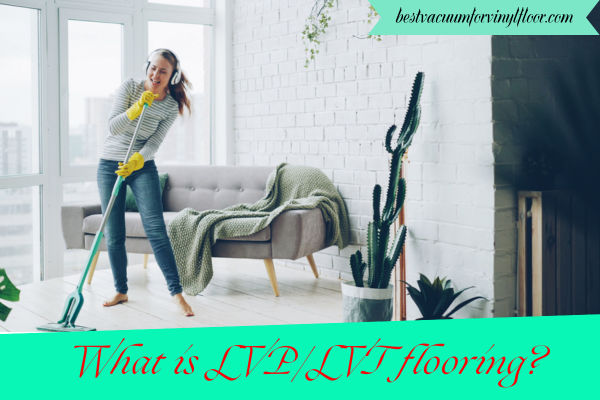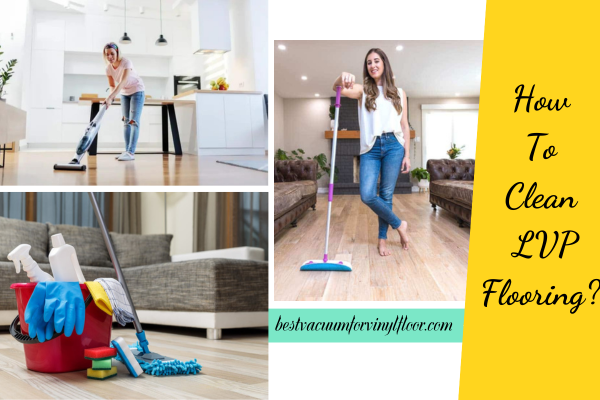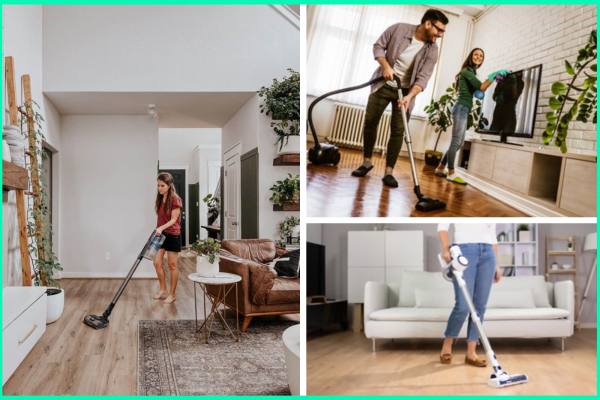What is LVP/LVT flooring?
Before learning How to clean LVP flooring, let’s find out what is LVP (LVT) floor?
Luxury Vinyl Tile (LVT) and Luxury Vinyl Plank (LVP) are distinctive variations of luxury vinyl flooring. LVT mimics the appearance of traditional tiles, while LVP replicates the allure of hardwood floor planks. By understanding the unique features of each type, it becomes easier to choose the perfect luxury vinyl flooring for your space.
LVP stands for Luxury Vinyl Plank, and it refers to a type of resilient flooring material that closely mimics the appearance of natural materials like wood, stone, and ceramic tile. LVP flooring’s made using advanced manufacturing techniques that combine layers of vinyl material to create a highly durable and versatile flooring option. Here’s a closer look at what LVP flooring is:
Composition: LVP flooring’s typically composed of multiple layers that work together to provide both aesthetic appeal and functional benefits. The layers may include:
- Backing Layer: This layer provides stability and structural support to the flooring. It often includes materials like PVC or fiberglass to give the flooring its strength.
- Vinyl Core Layer: The core layer’s where the visual design’s printed. Advanced printing techniques, such as high-definition 3D printing, allow for intricate and realistic patterns that closely resemble natural materials like wood, stone, or tile.
- Wear Layer: The wear layer is a crucial component that provides protection against scratches, stains, and general wear and tear. It’s typically made from a clear, durable material that adds to the flooring’s longevity.
- Surface Texture Layer: Some LVP flooring has an additional layer that adds texture to the surface, enhancing the realistic feel of the material.
LVP popularity in modern homes and commercial spaces.
In recent years, LVP flooring has become increasingly popular in both residential and commercial spaces. It provides a unique combination of beauty, durability, and affordability that makes it an ideal choice for modern living. Not only is LVP highly resilient to everyday wear-and-tear, but its easy maintenance makes it an attractive option for busy households. Plus, the broad range of styles and colors available means that you can customize the look of your flooring to perfectly suit any space.

Highlight the importance of proper cleaning to maintain the appearance and longevity of LVP flooring.
The durability and easy maintenance of LVP flooring are two of its greatest selling points. To ensure your flooring looks great for years to come, it is important to take the proper precautions when cleaning. Regular sweeping or vacuuming can help remove dirt and dust that could otherwise scratch or dull the surface over time. Additionally, using a damp mop with mild cleaner’s the best way to clean and sanitize your LVP flooring without leaving any residue behind. For tougher spills or stains, you may need to use a stronger cleaning solution, but it is always best to refer to the manufacturer’s instructions for specific advice.
Let’s find out in more detail how to keep the LVP floor like new.
Ways to clean LVP flooring.
Here are the 5 best ways to clean LVP flooring. Depending on the actual situation, we choose the appropriate cleaning plan.
- Sweep or Vacuum
The first way is to sweep or vacuum your LVP floor regularly. This will help remove dirt, grime, or other debris that can scratch and dull the surface over time. To ensure a thorough deep clean, it is crucial to first sweep away loose debris from your floors. This proactive approach prevents such debris from becoming trapped in your mop, contributing to a more effective cleaning process.
You can use a vacuum cleaner, but choose a vacuum with adjustable suction and use a soft brush attachment, as this will be gentler on the floor than a standard nozzle.
- Mop with a Homemade LVP Floor Cleaner
The second way is to mop the floor with a homemade cleaner. This is one of the most efficient ways to clean LVP flooring, as it allows you to create your own natural cleaning solution that will not damage or leave any residue behind. To make your own cleaner, simply mix 1/2 cup of white vinegar with 2 gallons of warm water.
The vinegar’s acidity effectively binds to caked-on dirt and debris, hastening their removal. Moreover, vinegar not only cleans but disinfects without leaving any soapy or waxy residue, unlike many other cleaners.
Once you’ve made your cleaning solution, grab a microfiber mop and start working on the floors from one corner to the other. Make sure to keep wringing out your mop regularly as you go, so that it isn’t too wet. After mopping, use a dry cloth or paper towel to wipe away any remaining moisture.
- Remove Stains with Baking Soda
The third way is to use baking soda to tackle tricky stains. If you have stubborn marks that will not come out with your regular cleaner, sprinkle a few tablespoons of baking soda on the area and let it sit for 10 minutes or so before wiping away. Baking soda’s an excellent natural scrubber that helps lift dirt and debris without damaging the surface.
For tougher stains, you can make a paste of baking soda and water to spread over the area. Leave the paste for 15 minutes before wiping away with a damp cloth.
- Rubbing Alcohol
If none of the above methods work, consider using rubbing alcohol as an alternative. Soak a rag in rubbing alcohol and use it to gently remove stubborn stains from the affected area of your floor. Once the stain has been successfully removed, make sure you dry off the residue completely with a clean cloth.
- Remove Scuff Marks with WD-40
To effectively eliminate scuff marks from your LVP flooring, follow these steps:
Bước 1. Wet a towel with either WD-40.
Bước 2. Gently rub the scuff using the damp towel until it vanishes.
Bước 3. Lastly, ensure to thoroughly clean away any remnants of the oil by using a water and vinegar solution. [1]
How To Clean LVP Flooring
Detailed instructions on how to clean LVP flooring.

Bước 1. Dusting and Sweeping
Begin by dry sweeping or dusting the floor to remove loose dirt, debris, and dust. This helps prevent the dirt from becoming embedded in the floor’s finish which can affect its longevity to prevent scratches during the wet cleaning process.
Bước 2. Sweep and Vacuum
Next, use a vacuum cleaner or broom to sweep the floor a second time. Choose a vacuum with adjustable suction and a soft brush attachment to remove finer particles and ensure a thorough cleaning.
See More: Best Vacuum For Vinyl Floors
Bước 3. Mop with Cleaner
After you’ve swept away any stains, moisten your LVP floor with the Homemade LVP Floor Cleaner introduced above. Be sure to wring out your mop regularly so it doesn’t get wet.
Bước 4. Rinse and Dry
Once you have finished mopping, use a clean towel or cloth to wipe away any remaining liquid on the surface of your LVP flooring. The floor should be damp – not soaking wet – so repeat this process until the area’s dry.
Bước 5. Removing Stains and Spills
If there are any stains or spills on your LVP flooring, you should take extra care to clean them as soon as possible with the appropriate cleaner or solvent. Refer to the manufacturer’s instructions for advice on how to tackle specific stains and spills.
Bước 6. Finishing Touches
Once your floor is clean and dry, you can give it a final touch with a polish that’ll help protect the surface and add shine. This step’s optional but helps to increase the lifespan of your LVP flooring.
With proper cleaning, you can ensure that your luxury vinyl plank floors will look beautiful and last for years to come. [2]
Summary of tips to help protect LVP floors
To keep your vinyl flooring looking the same as it did the day you installed it, Follow these top tips from the professionals.
Do:
- To effectively water and dirt into indoor spaces, it is highly recommended to install entrance mats.
- Sweep or vacuum regularly to remove dirt and dust. Use a damp mop with mild cleaner for regular cleaning.
- To prevent indentation marks on your LVP flooring caused by heavy furniture, it’s recommended to use felt pads or cups on the bottom of legs and castors. .
- Create your own homemade cleaner with 1/2 cup of white vinegar and 2 gallons of warm water.
- Use baking soda for tough stains, turning it into a paste with water if needed.
- Clean away any spills and stains as soon as possible.
- To minimize fading, it’s highly recommended to shield your floor from direct sunlight, especially in areas with windows facing the West.
Don’t:
- Do not use abrasive cleaners or tools to clean your LVP floors.
- Avoid over wetting the floor when mopping, so it does not become too slippery.
- Never scrub hard on the surface of your LVP floors.
- Don’t use WD-40 on areas other than scuff marks.
- Never apply wax or polish to the floor, as this could damage its finish.
By following these simple steps, you can keep your Luxury Vinyl Plank (LVP) floor looking great for years to come!
FAQ – How to clean LVP floors.

What is the best way to clean an LVP floor?
To prevent damage to the surface of vinyl tiles, it is important to refrain from soaking or wetting the floor. Instead, utilize a well wrung out mop or cloth to gently wipe at the stain. If this method proves ineffective, consider using a soft bristled brush to remove the mark. Remember to employ gentle movements throughout the process.
Regularly sweeping and vacuuming, use 1/2 cup of white vinegar with 2 gallons of warm water, tackling stains with baking soda, and taking extra care of scuff marks with WD-40 are all effective ways to maintain your LVP floors.
What should you not use to clean luxury vinyl plank flooring?
To clean luxury vinyl plank (LVP) flooring, avoid using strong cleaners, abrasive tools, steam hot, excessive water, or harsh chemicals. Do not use wax, polish, ammonia, or strong solvents. Avoid rubber-backed mats or rugs. Always follow the manufacturer’s guidelines for cleaning. Use a soft-bristle brush, vacuum with a soft brush attachment, or microfiber mop for regular dust and dirt removal.
Can you use Clorox wipes on LVP?
Using Clorox wipes or disinfecting wipes on Luxury Vinyl Plank (LVP) floors has the potential to damage the protective finish or discolor the floor. It’s best to consult the manufacturer’s instructions for approved cleaning products. If disinfecting wipes aren’t recommended, consider using a mild pH neutral floor cleaner like white vinegar with warm water. Always test in an inconspicuous area before extensive use. Priority is given to protecting the appearance and integrity of the floor.
Is vinegar safe for LVP?
Learn the effortless way to keep your LVP flooring clean without causing any damage. By utilizing a specific substance with acidic properties, you can achieve remarkable results. Just mix a cup of distilled white vinegar with a gallon of hot water (or a ratio of one part vinegar to 16 parts water) and effortlessly mop your floors.
Can you clean LVP with a steam mop?
While some steam mops do offer adjustable settings and could potentially be used on Luxury Vinyl Plank (LVP) flooring, it’s crucial to exercise caution. Before using a steam mop, carefully review your LVP manufacturer’s guidelines and test the steam mop in a discreet area to ensure it doesn’t cause any adverse effects.
What is the best mop for LVP tiles?
The Dyson V11 Torque Drive Cordless Vacuum is an exceptional option for cleaning LVP floors. Not only does it feature adjustable suction for tailored cleaning power, but its cordless design also offers unparalleled convenience and maneuverability, allowing you to effortlessly clean around furniture and in tight spaces.
Equipped with a variety of attachments, including a soft roller cleaner head designed specifically for hard floors like LVP, this vacuum ensures gentle yet effective cleaning without scratching or damaging your beautiful tiles. Moreover, the vacuum’s advanced filtration system efficiently captures dust and particles, resulting in cleaner and healthier LVP floors.
Can you use Dettol on LVP?
When disinfecting, the instructions suggest using an antibacterial cleaner like Dettol Multi-purpose Liquid. You can apply it with a mop or a damp cloth, diluted with water or undiluted depending on your needs. However, it’s important to note that using such disinfectants on Luxury Vinyl TPlank (LVP) flooring may potentially damage the protective wear layer. To ensure the integrity and appearance of your LVP flooring, it’s recommended to consult your LVP manufacturer’s guidelines and test the cleaner in an inconspicuous area before widespread use. Using pH-neutral, LVP-approved cleaners is often a safer option.
Is there a polish for vinyl flooring?
You can indeed use “Lifeproof Resilient Floor Low Gloss Polish” on your vinyl flooring, including LVP. However, it’s crucial to comply with the manufacturer’s application guidelines. It’s advisable to conduct a small area test before application and verify that the product is suitable for vinyl floors. Remember, regular cleaning and proper maintenance play a vital role in ensuring the long-term care of your flooring.
Can you clean LVP with Pine Sol?
For your vinyl floors, Pine-Sol Multi-Surface Cleaner is a suitable choice. It’s advised to use it with caution, though, by diluting it with water. Avoid oversaturating your floors; simply use an adequate amount for effective disinfection.
How to care for LVP flooring?
To care for LVP flooring:
- Regular Sweeping: Sweep or vacuum to remove dirt and debris.
- Damp Mopping: Use a damp mop with pH-neutral, LVP-approved cleaner.
- Avoid Harsh Cleaners: Do not use abrasive cleaners, vinegar, or bleach.
- Protect from Scratches: Place felt pads under furniture legs.
- Immediate Cleanup: Wipe spills promptly to prevent staining.
- Gentle Tools: Use soft-bristle brooms or microfiber mops.
- Manufacturer Guidelines: Follow manufacturer’s care instructions.
Is LVP completely waterproof?
LVP (Luxury Vinyl Plank) flooring is water-resistant but not completely waterproof. It can handle moisture better than hardwood or carpet, but prolonged exposure to water can still cause damage over time. For areas with high moisture, consider enhanced water-resistant options and proper maintenance.
Is LVP more waterproof than laminate?
Yes, LVP (Luxury Vinyl Plank) is typically more waterproof than laminate flooring due to its vinyl composition and multi-layer structure, providing better resistance to water damage and moisture-related issues.
Does sunlight damage LVP?
Prolonged exposure to direct sunlight can potentially fade and damage LVP flooring over time. Using window treatments or UV-blocking coatings can help minimize this effect.
More people read more: How To Get Paint Off Vinyl Floor – Tips To Remove Paint From Vinyl Floor?
Conclusion How To Clean LVP Flooring?
Maintaining and cleaning Luxury Vinyl Tile (LVP) flooring is easy when you know the right steps and techniques. With a few simple steps, you can keep your LVP floors looking brand new for years to come. Regularly sweeping and vacuuming, using a homemade cleaner, tackling stains with baking soda, and taking extra care of scuff marks with WD-40 are all effective ways to maintain your LVP floors. Additionally, using entrance mats to reduce the amount of dirt and moisture coming in from outdoors is essential for preserving their look and quality. With proper cleaning and maintenance, you can ensure that your Luxury Vinyl Plank flooring’ll last a long time!

